How to Tie a Spider Hitch Knot
An effective knot for when you plan on fishing with light tackle and want to tie a strong double line knot to connect your main fishing line to a leader.
When to Use a Spider Hitch Knot
You might be wondering; what is a spider hitch knot used for? The primary purpose of a spider hitch fishing knot is to create a strong doubled line connection when fishing with light tackle. Once tied, the spider hitch knot creates a loop that is used to connect your main line to your leader.
The spider hitch is often considered to be stronger and faster to tie than a dropper loop. Although, the spider hitch creates a loop at the end of a line, while a dropper loop is generally used to attach multiple rigs or hooks along a length of line. After using these two knots, you may find that the spider hitch knot or dropper loop both work well for you in different situations.
How to Tie a Spider Hitch Fishing Knot
When you are ready to learn how to tie a spider hitch knot for fishing, just follow these seven steps:
- Double over a length of line and form a loop.
- Hold the loop between thumb and forefinger.
- Wrap the double line around your thumb and the loop five times (wrap the doubled line 15 times if using braided fishing line).
- Pass the end of the double line behind the loop, and then through the loop.
- Pull the end out of the loop.
- Slowly pull on both ends to neatly unwind the double line off of your thumb and tighten the knot.
- Trim the tag end.
If you want to learn how to tie other easy fishing knots, check the "How to Tie Fishing Knots" section to get step-by-step directions and watch videos.
KEEP LEARNING

How to Tie the Non-Slip Loop Knot
The non-slip loop knot is a popular and reliable choice for securing hooks, lures, and other tackle to your fishing line.
LEARN MORE

Socials
Take me fishing social media links
LEARN MORE

TakeMeFishing x Teen Vogue
Join us on a creative journey as fashion designer Ahmrii Johnson walks us through her collaborative vision and process with Teen Vogue and fashion brand, Rentrayage, to create a special piece.
LEARN MORE


.png?lang=en-US&ext=.png)